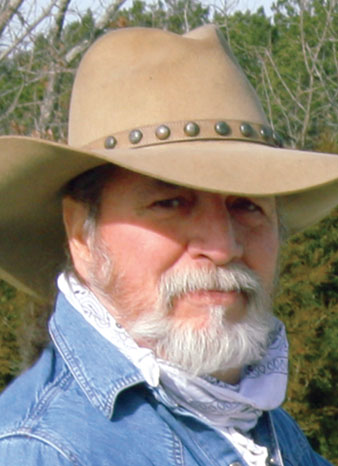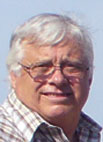
When Gary Koch was a young man, he and his grandfather raised Shorthorn cattle. He later had Hereford and Angus.
As the years went on, Gary became a union carpenter in the St. Charles, Mo., area, but he continued raising cattle. At one time he had farms in Arkansas, but he still lived in St. Charles, so he comminuted about five hours, one way, to his cattle operation.
After he retired about 10 years ago, Gary and his wife Debra sold their Arkansas holdings and moved to rural Licking, Mo., to a farm near the Texas/Dent county line.
“I was raised on a hill farm and I’ve come back to a hill farm,” he said with a laugh.
Today, Sylvanglades Farm is home to a herd of 25 American British White Park cattle.
The story of how the American British White Park came to be in the United States varies, but historical accounts agree that White Park cattle were brought to Canada from England in the 1930s. Some say the cattle were sent to Canada so that the line could be preserved as World War II ranged in England, while others say the import was a business deal. Gary said some of the original bloodlines can be found at a few ranches across the country.
The trademarks of the American British White Park are black noses and ears, and black around the eyes. The cattle are primarily white or roan, but predominately black offspring are not uncommon, possibly through the introduction of Angus into the bloodlines of the original cattle brought to North America. Bulls that do not display the distinguishing characteristics, meaning they are under marked (little or no black features) or over marked (too much black) may not be registered as an American British White Park. Heifers, however, can be registered as halfbloods.
Gary opted for the naturally polled breed about 15 years ago after researching cattle that offered good temperament and required little maintenance.
“These cattle are as gentle as they say they are,” Gary said as he walked up to one of his foundation cows and began scratching her back. “They are easy to handle. I only use my dogs because I like training Border Collies; I don’t need them, except to get the cows to move because they just stand around and won’t go. When we get them down to the catch pens, I can just walk in and do what I need to do. I don’t have to have help. Sorting them is like a slow dance.”
He bought some of his first herd members from registered breeders in Illinois and Iowa, and several of those females are still productive members of his herd at the age of 14 or 15.
“They’re really the best cattle I’ve ever had,” Gary said. “They preform on almost nothing. I feed no grain, other than when I call them up once in a while. When I wean, I will give them some grain then, but they pretty much survive on grass.”
He added that the longevity of the females was also a selling point for him.
Gary owns and leases about 100 acres of grazeable pasture. Gary said pastures are about 50 percent clover and he over seeds “just about any” legume.
“I don’t have any problems with fescue toxicity,” Gary said. “I use a lot of lespedeza, the poor man’s alfalfa, and things like that so that the cows can get a little variety.”
American British White Park are a moderate-framed and muscled breed, with cows reaching between 1,000 and 1,500 pounds. Gary said udders are typically small, yet they are able to produce an ample milk supply for their calves. He added that the breed is also very adaptive to its climate, tolerating hot and cold weather well.
Gary said he has very few calving issues.
“Cattle will be cattle,” he said. “There are so many factors involved, like disease and nutrition, anything like that. I don’t want to guarantee people there won’t be a problem.”
Gary’s herd is set up for a spring calving cycle, but he prefers fall calves.
“We can’t complain this year, but some winters can get pretty bad. I haven’t lost any calves, but there are times when they were almost frozen,” Gary recalled. “I’d rather calve in the fall because you beat the weather and you don’t have the flies. With a fall calf, it seems like they just do better, to me.”
Calves are weaned at about 6 months of age, but if weather conditions, such as a drought, or if cows are not holding weight, Gary will wean a little earlier.
While he has a registered herd, Gary admits he has done a little crossbreeding in the past, but none of the off spring was retained for the herd.
“I used a Red Angus bull one year because everyone asked me how they crossed,” Gary said. “I had all kinds of calves and they were outstanding. They were up and running around the cow in an hour. I sold all of those calves to kids for the fairs because the temperament transported over. I don’t know how they did in the fair, but the kids really liked them. Women like these because they are pretty to look at, and kids like them because they are easy to handle.”
Gary markets his cattle directly to customers. Because of the homesteader markets, he has considered crossing with a Jersey to evaluate the milk production of the cross to investigate the possibility of a more duel-purpose animal.
There are few overall health issues with Gary’s Closed American British White Park herd, but he does follow a vaccination protocol for all animals to insure their stay healthy, and believes animals should be treated with antibiotics, when necessary.
“That isn’t going into the meat; it’s going into a animal that will produce meat,” he said.
He also said he has not needed to worm his cattle in several years.
Gary said he has found his perfect breed and the perfect place to raise them.
“This is cattle country,” he said. “We don’t have the best land and we grow rocks better than anything else, but this is a real cattleman friendly area… I just can’t talk enough about these cows. They are really hard to beat.”








Can I get Gary’s info so I could purchase some cattle.